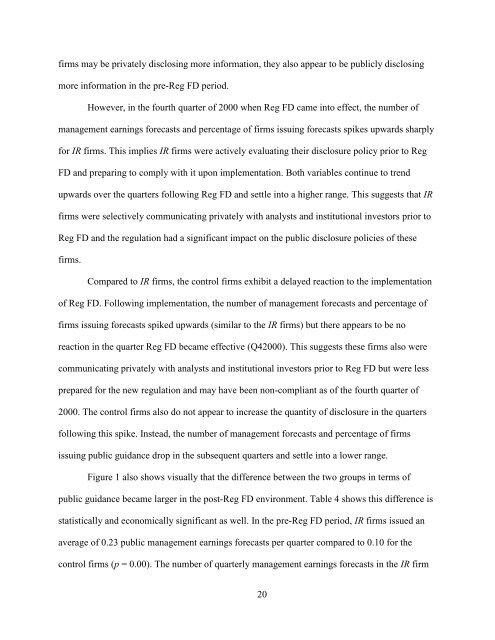Investor Relations and Regulation FD
Investor Relations and Regulation FD
Investor Relations and Regulation FD
You also want an ePaper? Increase the reach of your titles
YUMPU automatically turns print PDFs into web optimized ePapers that Google loves.
firms may be privately disclosing more information, they also appear to be publicly disclosing<br />
more information in the pre-Reg <strong>FD</strong> period.<br />
However, in the fourth quarter of 2000 when Reg <strong>FD</strong> came into effect, the number of<br />
management earnings forecasts <strong>and</strong> percentage of firms issuing forecasts spikes upwards sharply<br />
for IR firms. This implies IR firms were actively evaluating their disclosure policy prior to Reg<br />
<strong>FD</strong> <strong>and</strong> preparing to comply with it upon implementation. Both variables continue to trend<br />
upwards over the quarters following Reg <strong>FD</strong> <strong>and</strong> settle into a higher range. This suggests that IR<br />
firms were selectively communicating privately with analysts <strong>and</strong> institutional investors prior to<br />
Reg <strong>FD</strong> <strong>and</strong> the regulation had a significant impact on the public disclosure policies of these<br />
firms.<br />
Compared to IR firms, the control firms exhibit a delayed reaction to the implementation<br />
of Reg <strong>FD</strong>. Following implementation, the number of management forecasts <strong>and</strong> percentage of<br />
firms issuing forecasts spiked upwards (similar to the IR firms) but there appears to be no<br />
reaction in the quarter Reg <strong>FD</strong> became effective (Q42000). This suggests these firms also were<br />
communicating privately with analysts <strong>and</strong> institutional investors prior to Reg <strong>FD</strong> but were less<br />
prepared for the new regulation <strong>and</strong> may have been non-compliant as of the fourth quarter of<br />
2000. The control firms also do not appear to increase the quantity of disclosure in the quarters<br />
following this spike. Instead, the number of management forecasts <strong>and</strong> percentage of firms<br />
issuing public guidance drop in the subsequent quarters <strong>and</strong> settle into a lower range.<br />
Figure 1 also shows visually that the difference between the two groups in terms of<br />
public guidance became larger in the post-Reg <strong>FD</strong> environment. Table 4 shows this difference is<br />
statistically <strong>and</strong> economically significant as well. In the pre-Reg <strong>FD</strong> period, IR firms issued an<br />
average of 0.23 public management earnings forecasts per quarter compared to 0.10 for the<br />
control firms (p = 0.00). The number of quarterly management earnings forecasts in the IR firm<br />
20
















